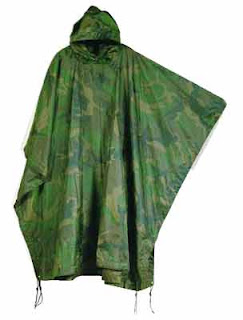
....one may effectively combat the elements, and more!
If you invest in a decent, military grade ripstop nylon, or older urethane coated, poncho, you instantly own an incredibly useful and versatile survival tool. Even the thinner, cheaper disposeable type made of vinyl will suffice for temporary use. For the small amount of space that a poncho occupies, the return benefits are potentially enormous if you use your imagination. I was just thinking about this as the rainy season is just ending here and I put my trusty old poncho away in my "rain/cold weather" MOLLE pouch. This belt pouch module (6" X 6" X 3") contains my rain poncho, an emergency bivy sack, a Nomex balaclava (which rolls up like a watch cap), and a chemical hand-warmer packet. This compact "module" keeps me prepared for inclement weather or even an unscheduled night out in the elements. I should explain more about this "module" system later, but it is part of my basic preparedness kit or BOB (which stands for "Bail Out Bag" or "Bug Out Bag", or alternately a Go Bag if you prefer). Should an emergency occur, I always have this bag close at hand, wherever I am. But I shall write more about this at length.
Ponchos are available seemingly everywhere. Almost every military in the world issues them. There are many high-quality commercial brands (like REI, Outdoor Products, Jansport) for camping and outdoors people also. The technology is simple. A poncho is not much more than a large piece of cloth, ostensibly water-proof with a headhole that allows it to be worn, completely covering the front and back of the body (including equipment and pack). The technology dates back to the American Civil War when Union soldiers were issued "Gum Blankets" which were pieces of canvas coated with a rubber mixture (made by "Goodyear" believe it or not!). It is very effective as raingear. Ah! but a modern poncho can be so much more.
-Though not the most effective at this function, a poncho is a rudimentary (minimally insulative) blanket. When used in combination with a quilted poncho liner, it becomes a very effective blanket.
-When laid out on the ground, it's a nice waterproof ground cloth. Basically like any tarpaulin.
-When snapped into a tube, it forms a simple sleeping bag. With my quilted poncho liner with Holofil II, a silk liner sheet, my poncho and insulated ground blanket, I have my own 3-season sleep system, very versatile and portable. It's like a "mini" sleeping bag.
-This same tube makes a field expedient body bag.
-In Ranger School, they teach a technique by which two ponchos can be sealed together to make a pontoon float that can buoy two full rucksacks.
-A poncho is very effective for smoke signalling (trapping and accumulating smoke).
-When suspended or supported overhead, it makes a good shelter (or tent). It can also protect (shelter) individual objects sensitive to moisture.
-This same shelter idea can be used to collect water (rain) in a survival situation, channeling into a basin or canteen.
-Similarly, it can be hung up as a wind/sun shelter or blind to conceal something.
-It's wind catching ability can be capitalized on to form a sail, if lost at sea or on open water.
-The technique is not easily explained (in text), but a poncho (and many sticks) can be used to make an effective "fish trap" in a survival situation.
-Like any large piece of cloth, it can be an emergency catch blanket for someone to jump down into from a height.
-Like any large piece of cloth, it can be a drag sled or litter (for dragging game, or tranporting an injured person).
-With a couple of poles it becomes a travois or stretcher.
-Similarly, it can be used to carry large, heavy loads of anything (firewood, dirt, stones, ammo, forage).
-If rolled, folded correctly, it can carry several gallons of water in one load for short distances.
-Although I wouldn't trust my weight on it as a "hammock", I have personally used a poncho along with rope and paracord to help hold/haul loads up into a tree blind and to suspend food away from bears and critters.
Looking at Native American "shirts" in museums, one can see that the poncho idea (a headhole through an animal skin) is the basis for much early clothing. One of the great things about a poncho as clothing is that it can be easily improvised (like in Rambo: First Blood). A rectangular piece of cloth, headhole and some rope to belt it off. And anything waterproof, like a trash can liner, upholstery, a rug, animal skin or tarp, can become poncho for raingear or warmth.
Similar to the clothing concept, the poncho forms a basic cape, and if the poncho is camofluaged or matches the environmental colours, it makes a decent "mobile" sniper veil. This type of poncho is actually an issue item in Eastern Bloc armies.
I haven't tried out the concept myself, but there is something called an "Alpha Tent" that someone online was promoting. It's basically using some old tent poles in an "X" pattern and putting the ends through the corners of military sized poncho. It forms itself into a surprisingly effective "dome" which one can readily shelter under. You can check it out here at http://www.alpharubicon.com/prepinfo/ponchotent.htm
No comments:
Post a Comment